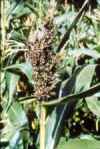| |
Diseases of Vegetables - Corn | |
| |
|
|
| |
|
|
| | Gibberella Ear Rot (Pink Rot).
Gibberella zeae (Fusarium graminearum) and Trichoderma sp.
What to look for?
A toxin producing disease of corn of consideralbe economic importance.. These mycotoxins are a health hazard to livestock and man. Initial stages are a pink mold that later may become black (black perithecia). Sometimes frosts may injure the corn ears and they may be rapidly colonized by saprophytic fungi such as Trichoderma sp. which could be mistaken for Fusarium graminearum.

Photo: Sutton | Picture description
Pink ear rot and Trichoderna damage. |
.
Management strategy
This is the same fungus that causes head blight and induces toxins in wheat, barley and oats. Crop rotation reduces levels of this disease and avoid feeding infected grain to hogs
Head Smut.
Sphacelotheca reiliana (Sporisorium holci-sorghi)
What to look for?
A sporadic disease in Canada and very distinct from the common smut found everywhere. The head smut fungus enters seedlings and grows internally in the corn plant. Symptoms only appear when the ears and tassels are formed. Tassels look like sooty wire brushes and ears may be replaced with leaf-like proliferations.

Photo: Seaman | Picture description
Tassel infection. |

Photo: Seaman | Picture description
Ear infection by the fungus. |

Photo: Sweeney | Picture description |  |  |
.
Management strategy
Crop rotation and resistant hybrids give good disease control.
Holcus Spot.
Pseudomonas syringae
What to look for?
This disease shows up on young corn after rainstorms or hail. The water soaked spots dry to a white or tan colour. This bacterial disease seldom causes any significant crop loss.

Photo: Howard | Picture description
Distinct tan spots. |
.
Management strategy
Rust.
Puccinia sorghi
What to look for?
A common occurrence on corn usually very late in the growing season. Rust spores do not overwinter in Canada. The dark brown teliospores produced late in the season overwinter in the United States. These teliospores must give rise to basidiospores that infect wild sorrel (Oxalis sp.). Spores (aeciospores) from the alternate host sorrel can then infect corn. The resulting red rust urediniospores on corn then move north into Canada.

Photo: Zimmer | Picture description
Rust infection on corn. |
.
Management strategy
Other Diseases
Northern Leaf Blight (Cochliobolus carbonum)
Southern Leaf Blight (Cochliobolus heterostrophus)
Yellow Leaf Blight (Mycosphaerella zeae-maydis)
Common Smut (Ustilago zeae)
Stalk Rots (Colletotrichum, Gibberella, Fusarium, Diplodia and Pythium sp.)
Photographs and information assembled and prepared for ARD by Dr. Ieaun R. Evans Agri-Trend Agrology Ltd. |
|
| |
|
|
| |
Other Documents in the Series |
|
| |
Diseases of Vegetables
Diseases of Vegetables - Carrot
Diseases of Vegetables - Celery
Diseases of Vegetables - Corn - Current Document
Diseases of Vegetables - Cucumber
Diseases of Vegetables - Garlic
Diseases of Vegetables - Lettuce
Diseases of Vegetables - Muskmelon
Diseases of Vegetables - Onion
Diseases of Vegetables - Parsnip
Diseases of Vegetables - Pea
Diseases of Vegetables - Zucchini
|
|
| |
|
|
| |
For more information about the content of this document, contact Robert Spencer.
This information published to the web on December 9, 2003.
Last Reviewed/Revised on April 7, 2014.
|
|